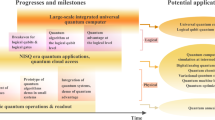Abstract
We study the dynamics of quantum correlations of the systems consisting of two non-interacting superconducting qubits interacting with their own data bus and common data bus, where the qubits are driven by a controllable time-dependent electromagnetic field. We investigate how the time-dependent electromagnetic field affects the dynamics of the quantum discord and the three-partite entanglement of the systems. It is found that the quantum discord vanishes only asymptotically although entanglement disappears suddenly during the time evolution and the quantum discord between two qubits can be increased by adjusting the time-dependent electromagnetic field.
Similar content being viewed by others
References
Nielsen M.A., Chuang I.L.: Quantum Computation and Quantum Information. Cambridge University Press, Cambridge (2000)
Horodecki R., Horodecki P., Horodecki M., Horodecki K.: Quantum entanglement. Rev. Mod. Phys. 81(2), 865–942 (2009)
Meyer D.A.: Sophisticated quantum search without entanglement. Phys. Rev. Lett. 85(9), 2014–2017 (2000)
Datta A., Shaji A., Caves C.M.: Quantum discord and the power of one qubit. Phys. Rev. Lett. 100(5), 050502 (2008)
Ollivier H., Zurek W.H.: Quantum discord: a measure of the quantumness of correlations. Phys. Rev. Lett. 88(1), 017901 (2002)
Zurek W.H.: Quantum discord and maxwells demons. Phys. Rev. A 67(1), 012320 (2003)
Horodecki M., Horodecki P., Horodecki R., Oppenheim J., Sen(De) A., Sen U., Synak-Radtke B.: Local versus nonlocal information in quantum-information theory: formalism and phenomena. Phys. Rev. A 71(6), 062307 (2005)
Shabani A., Lidar D.A.: Vanishing quantum discord is necessary and sufficient for completely positive maps. Phys. Rev. Lett. 102(10), 100402 (2009)
Datta A., Gharibian S.: Signatures of nonclassicality in mixed-state quantum computation. Phys. Rev. A 79(4), 042325 (2009)
Werlang T., Souza S., Fanchini F.F., Villas Boas C.J.: Robustness of quantum discord to sudden death. Phys. Rev. A 80(2), 024103 (2009)
Wang B., Xu Z.-Y., Chen Z.-Q., Feng M.: Non-Markovian effect on the quantum discord. Phys. Rev. A 81(1), 014101 (2010)
Makhlin Y., Schön G., Shnirman A.: Quantum-state engineering with Josephson-junction devices. Rev. Mod. Phys. 73(2), 357–400 (2001)
Clarke J., Wilhelm F.K.: Superconducting quantum bits. Nature (London) 453, 1031 (2008)
Chen M.-Y., Tu M.W.Y., Zhang W.-M.: Entangling two superconducting lc coherent modes via a superconducting flux qubit. Phys. Rev. B 80(21), 214538 (2009)
Majer J., Chow J.M., Gambetta J.M., Koch J., Johnson B.R., Schreier J.A., Frunzio L., Schuster D.I., Houck A.A., Wallraff A., Blais A., Devoret M.H., Girvin S.M., Schoelkopf R.J.: Coupling superconducting qubits via a cavity bus. Nature (London) 449, 443 (2007)
You J.Q., Tsai J.S., Nori F.: Scalable quantum computing with Josephson charge qubits. Phys. Rev. Lett. 89(19), 197902 (2002)
You J.Q., Nori F.: Quantum information processing with superconducting qubits in a microwave field. Phys. Rev. B 68(6), 064509 (2003)
Zagoskin A.M., Grajcar M., Omelyanchouk A.N.: Selective amplification of a quantum state. Phys. Rev. A 70(6), 060301 (2004)
Blais A., van den Brink A.M., Zagoskin A.M.: Tunable coupling of superconducting qubits. Phys. Rev. Lett. 90(12), 127901 (2003)
Liu Y.-X., Sun C.P., Nori F.: Scalable superconducting qubit circuits using dressed states. Phys. Rev. A. 74, 052321 (2006)
Johansson J., Saito S., Meno T., Nakano H., Ueda M., Semba K., Takayanagi H.: Vacuum rabi oscillations in a macroscopic superconducting qubit lc oscillator system. Phys. Rev. Lett. 96(12), 127006 (2006)
Zhang, Y.Q., Xu., J.B.: Entanglement control in a superconducting qubit system by an electromagnetic field. Eur. Phys. J. D. (2011). doi:10.1140/epjd/e2011-20086-3
Wootters W.K.: Entanglement of formation of an arbitrary state of two qubits. Phys. Rev. Lett. 80(10), 2245–2248 (1998)
Myatt C.J., Rowe M., Turchette Q.A., Itano W.M., Wineland D.J., Monroe C.: Experimental entanglement of four particles. Nature 404, 256 (2000)
Seevinck M., Uffink J.: Sufficient conditions for three-particle entanglement and their tests in recent experiments. Phys. Rev. A 65, 012107 (2001)
Author information
Authors and Affiliations
Corresponding author
Rights and permissions
About this article
Cite this article
Zhang, YQ., He, QL. & Xu, JB. Enhancing quantum discord in superconducting qubit systems by a controllable electromagnetic field. Quantum Inf Process 12, 1335–1350 (2013). https://doi.org/10.1007/s11128-012-0476-6
Received:
Accepted:
Published:
Issue Date:
DOI: https://doi.org/10.1007/s11128-012-0476-6




